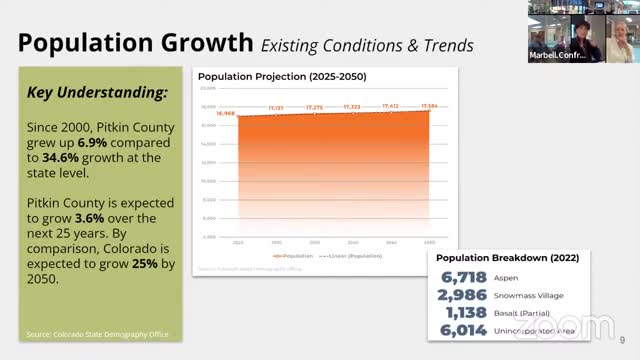Population growth projections reveal hidden challenges in Pitkin County
October 01, 2024 | Pitkin County, Colorado
This article was created by AI summarizing key points discussed. AI makes mistakes, so for full details and context, please refer to the video of the full meeting. Please report any errors so we can fix them. Report an error »

In a recent government meeting, officials discussed the demographic trends and population projections for Pitkin County, revealing significant disparities between local growth and state averages. Since 2000, Pitkin County's permanent resident population has grown by approximately 7%, a stark contrast to Colorado's overall growth rate of 35%. Looking ahead, the county is projected to see a modest increase of 3.6% over the next 25 years, while the state anticipates a growth rate of 25%.
The meeting highlighted that neighboring counties, such as Eagle and Garfield, are expected to experience much higher growth rates of 37% and 43%, respectively. This slower growth in Pitkin County is attributed to an aging population, a declining birth rate, and a trend of younger residents leaving the area.
Officials noted that the current demographic data, primarily sourced from the State Demography Office and census information, may not fully capture the actual population dynamics. The definition of \"permanent resident\" was clarified as individuals who register to vote and maintain a permanent address in the county, which excludes many seasonal residents and second homeowners who may live in the area for most of the year but retain their primary residence elsewhere.
Concerns were raised about the implications of these demographic trends on local infrastructure and services. The current population estimate of around 17,000 permanent residents does not reflect the actual community experience, particularly during peak tourist seasons. Officials acknowledged the need for more nuanced data collection methods to better understand the intensity of visitation and its impact on local resources.
The discussion underscored the importance of accurately quantifying the population and its fluctuations to inform planning and resource allocation. As the county grapples with the strain on infrastructure and public services, officials emphasized the necessity of aligning demographic data with the lived experiences of residents to effectively address community needs.
The meeting highlighted that neighboring counties, such as Eagle and Garfield, are expected to experience much higher growth rates of 37% and 43%, respectively. This slower growth in Pitkin County is attributed to an aging population, a declining birth rate, and a trend of younger residents leaving the area.
Officials noted that the current demographic data, primarily sourced from the State Demography Office and census information, may not fully capture the actual population dynamics. The definition of \"permanent resident\" was clarified as individuals who register to vote and maintain a permanent address in the county, which excludes many seasonal residents and second homeowners who may live in the area for most of the year but retain their primary residence elsewhere.
Concerns were raised about the implications of these demographic trends on local infrastructure and services. The current population estimate of around 17,000 permanent residents does not reflect the actual community experience, particularly during peak tourist seasons. Officials acknowledged the need for more nuanced data collection methods to better understand the intensity of visitation and its impact on local resources.
The discussion underscored the importance of accurately quantifying the population and its fluctuations to inform planning and resource allocation. As the county grapples with the strain on infrastructure and public services, officials emphasized the necessity of aligning demographic data with the lived experiences of residents to effectively address community needs.
View full meeting
This article is based on a recent meeting—watch the full video and explore the complete transcript for deeper insights into the discussion.
View full meeting
